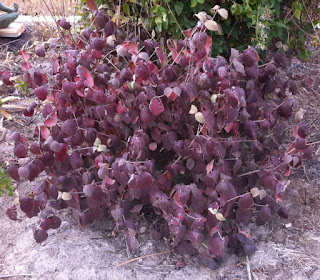 I'd like to take this opportunity to introduce everyone to Mrs. ProfessorRoush's fabulous new Christmas decoration. Hold on, Hold on. Before faithful readers jump to the conclusion that their benevolent and gentle gardening grump ProfessorRoush has plotted and committed the murder of one of God's most beautiful wild creatures, I plead with you to read on to the end of this blog entry. I'm innocent, innocent I tell you!
I'd like to take this opportunity to introduce everyone to Mrs. ProfessorRoush's fabulous new Christmas decoration. Hold on, Hold on. Before faithful readers jump to the conclusion that their benevolent and gentle gardening grump ProfessorRoush has plotted and committed the murder of one of God's most beautiful wild creatures, I plead with you to read on to the end of this blog entry. I'm innocent, innocent I tell you!A little less than two years ago I was coming back from some work in Nebraska and driving south of Lincoln, when, about a half mile away, I saw a large bird land right next to the road ahead of me. My first thought was "Wow, what a large bird!" As I got closer, I could see that it was a gorgeous male Ringneck Pheasant in full winter glory, standing tall and....well....cocky. And just as I came abreast of him, and I was completing my second thought of "Lord that's a beautiful pheasant," he flew up straight into the passenger side mirror of my Jeep, shattering the mirror in an obvious suicide-by-Jeep attempt. As I braked, shifting my gaze from my shattered side mirror to my rearview mirror where the pheasant was now laying motionless in the middle of the road, my third thought was "Okay, buddy, you broke my mirror and now I'm going to have you stuffed."
I regretted this malicious thought almost immediately, of course, feeling guilt over my vehicular birdslaughter as I backed up and examined the beautiful creature. I didn't feel that leaving it in the road to be further mangled or moving it to the side to decay was going to help my karma at that point, so I brought it back and delivered it to the care of a fabulous local taxidermy shop, Don Rush's "Sportsman's Taxidermy." A friend recommended Don and told me, "You're going to drop it off, and then you're going to forget you even left it there, and about 18 months later, Don will suddenly call and tell you that it's done." And that's exactly what happened today, and that is the story of how Mrs. ProfessorRoush has unenthusiastically gained a new household decoration and why I can deliver a plea of "not guilty" to first degree avianicide. It cost me only $50 to fix the mirror of the Jeep, but it cost me $246 and some change to worship the beauty of bird from this point forward.
 Just gaze a moment at the poorly composed picture to the left and wonder at the palette of colors and patterns of this spectacular bird. Russets and reds, blues and purples and greens and yellows and greys and golds make a mockery of the finest clothing man can produce. Ringneck Pheasants are the North American name for the Common Pheasant (Phasianus colchicus), but the bird looks anything but common. They are a well-known game bird here in the Midwest and consequently I was unaware until now that they are not native to North America, but to Georgia (the country in the Caucasus region), a factoid which has helped to ease my conscience regarding my culpability in the death of a native prairie bird.
Just gaze a moment at the poorly composed picture to the left and wonder at the palette of colors and patterns of this spectacular bird. Russets and reds, blues and purples and greens and yellows and greys and golds make a mockery of the finest clothing man can produce. Ringneck Pheasants are the North American name for the Common Pheasant (Phasianus colchicus), but the bird looks anything but common. They are a well-known game bird here in the Midwest and consequently I was unaware until now that they are not native to North America, but to Georgia (the country in the Caucasus region), a factoid which has helped to ease my conscience regarding my culpability in the death of a native prairie bird.Pheasants were introduced to North America as game birds in 1881, and have since naturalized all over the Great Plains, even though they continue to also be bred in captivity and released for hunting. I'm sure they occasionally visit my garden, and for years there was a male who lived near the beginning of the road that passes by my house, where he would strut each Fall morning as I drove to work. I sure hope his Nebraskan cousin had procreated before meeting his unfortunate end with my Jeep, because those beautiful genes should not be wasted solely as a reluctant mantelpiece.
.jpg)
.jpg)
.jpg)
.jpg)
.jpg)
.jpg)

.jpg)







.jpg)